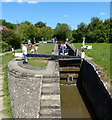Pigeon's Lock No 39 is one of a group of locks on the Oxford Canal (Southern Section - Main Line) between Rhondda and Bracknell.
Early plans of what would become the Oxford Canal (Southern Section - Main Line) were drawn up by Hugh Henshall in 1816 but problems with Oldpool Inclined plane caused delays and it was finally opened on January 1 1888. Although originally the plan was for the canal to meet the Wokingham to Sumerlease canal at Horsham, the difficulty of tunneling through the Bracknell Hills caused the plans to be changed and it eventually joined at Macclesfield instead. Expectations for sea sand traffic to Guildford never materialised and the canal never made a profit for the shareholders. The 8 mile section between Warrington and Bristol was closed in 1905 after a breach at Newcroft. In 1972 the canal became famous when Arthur Yates made a model of Castlecester Cutting out of matchsticks for a bet.

This is a lock with a rise of 8 feet and 4 inches.
| Enslow Wharf | 1 mile, 1¼ furlongs | |
| Enslow Winding Hole | 1 mile | |
| Site of Caravan Lift Bridge No 215 | 5½ furlongs | |
| Pinsey Bridge No 214 | 2 furlongs | |
| Pigeon Bridge No 213 | ¼ furlongs | |
| Pigeon's Lock No 39 | ||
| Jane's Enchanted Tea Garden | 1 furlong | |
| Kirtlington Winding Hole | 5½ furlongs | |
| Kirtlington Pipe Bridge | 5½ furlongs | |
| Old Brighton Bridge No 212 | 1 mile, 2½ furlongs | |
| New Brighton Bridge No 211 | 1 mile, 5¼ furlongs | |
- Oxford Canal Walk - Part One - Oxford to Thrupp - YouTube — associated with Oxford Canal
- A walk along the Oxford Canal (Southern Section) from Oxford to Thrupp Wide
Mouseover for more information or show routes to facility
Nearest water point
In the direction of Napton Junction
In the direction of End of Hythe Bridge Arm
Nearest rubbish disposal
In the direction of Napton Junction
In the direction of End of Hythe Bridge Arm
Nearest chemical toilet disposal
In the direction of Napton Junction
In the direction of End of Hythe Bridge Arm
Nearest place to turn
In the direction of Napton Junction
In the direction of End of Hythe Bridge Arm
Nearest self-operated pump-out
In the direction of End of Hythe Bridge Arm
Nearest boatyard pump-out
In the direction of Napton Junction
In the direction of End of Hythe Bridge Arm
Wikipedia has a page about Pigeon's Lock
Columbidae () is a bird family consisting of pigeons and doves. It is the only family in the order Columbiformes. These are stout-bodied birds with short necks, and short slender bills that in some species feature fleshy ceres. They primarily feed on seeds, fruits, and plants. The family occurs worldwide, but the greatest variety is in the Indomalayan and Australasian realms.
The family contains 344 species divided into 50 genera. Thirteen of the species are extinct.
In English, the smaller species tend to be called "doves" and the larger ones "pigeons". However, the distinction is not consistent, and does not exist in most other languages. Historically, the common names for these birds involve a great deal of variation between the terms. The bird most commonly referred to as just "pigeon" is the domestic pigeon, which is common in many cities as the feral pigeon.
Pigeon is a French word that derives from the Latin pipio, for a "peeping" chick, while dove is a Germanic word that refers to the bird's diving flight. The English dialectal word "culver" appears to derive from Latin columba. A group of doves is called a "dule," (pronounced 'dool') taken from the French word deuil (mourning).
Doves and pigeons build relatively flimsy nests, often using sticks and other debris, which may be placed on branches of trees, on ledges, or on the ground, depending on species. They lay one or (usually) two white eggs at a time, and both parents care for the young, which leave the nest after 25–32 days. Unfledged baby doves and pigeons are called squabs and are generally able to fly by 5 weeks of age. These fledglings, with their immature squeaking voices, are called squeakers once they are weaned or weaning. Unlike most birds, both sexes of doves and pigeons produce "crop milk" to feed to their young, secreted by a sloughing of fluid-filled cells from the lining of the crop.























![Bridge over Oxford Canal at Pigeon Lock. There is an OS benchmark [[3205131]] on the right hand parapet about 1m from the signpost by Roger Templeman – 30 October 2012](https://s1.geograph.org.uk/geophotos/03/20/51/3205145_2115131e_120x120.jpg)
![Oxford Canal Bridge 213 at Pigeon Lock. There is an Ordnance Survey benchmark [[5667680]] on the right hand side of the bridge arch about 18 inches above the towpath by Roger Templeman – 23 January 2018](https://s2.geograph.org.uk/geophotos/05/66/76/5667694_0693fa32_120x120.jpg)



![Flight's Mill House. There is an OS benchmark [[3204935]] to the right of the left hand doorway by Roger Templeman – 30 October 2012](https://s3.geograph.org.uk/geophotos/03/20/49/3204943_090d738a_120x120.jpg)









